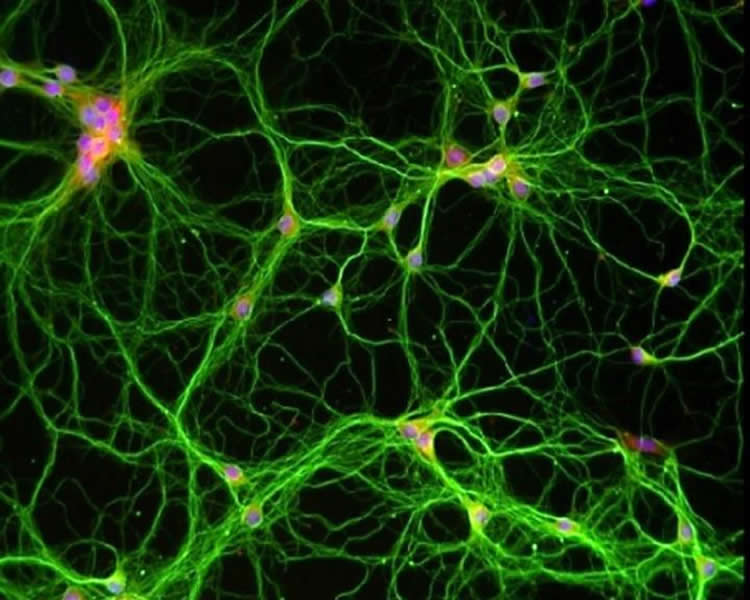Summary: Researchers find genetic clues as to how mice lay down spatial memories.
Source: University of Pennsylvania.
Penn study finds epigenetics key to laying down spatial memories in mouse brain, providing possible new neurological medications.
Understanding how memories are made, retrieved, and eventually fade over a lifetime is the stuff of poems and song. To medical researchers, solving the mysteries of memory is even more elusive. Researchers surmise that “laying down” a new memory and storing an old memory both involve making proteins at the space, or synapse, where one neuron meets another. But forming these also requires new gene expression in the cell nucleus, where DNA is stored and genes are “read” to establish cell-specific functions.
Now, researchers from the Perelman School of Medicine at the University of Pennsylvania have discovered, in the mouse brain, that a key metabolic enzyme works directly within the nucleus of neurons to turn genes on or off when new memories are being established. Their findings are published online this week in Nature.
“This enzyme, called acetyl-CoA synthetase 2, or ACSS2, ‘fuels’ a whole machinery of gene expression ‘on site’ in the nucleus of nerve cells to turn on key memory genes after learning,” said senior author Shelley L. Berger, PhD, the Daniel S. Och University Professor in the departments Cell and Developmental Biology and Biology and director of the Penn Epigenetics Program. “We found both direct gene-association of ACSS2 and a role for it in neurons to regulate learning and memory – two completely unanticipated novel discoveries.”
This study provides a new target for neuropsychiatric disorders, such as anxiety and depression, where neuro-epigenetic mechanisms are known to key, said first author Philipp Mews, PhD, a former graduate student in the Berger lab who is now a postdoctoral fellow at the Friedman Brain Institute of the Icahn School of Medicine at Mount Sinai in New York City. “We suspect,” Mews says, “that ACSS2 might play a role in memory impairment in neurodegenerative disorders.”
Forming memories involves restructuring of the synapse, which relies on the coordinated expression of a group of memory genes. The addition of a chemical group, a process called acetylation, onto specific spots of the genome in neurons, opens up tightly-wound DNA to make genes involved in memory formation available to be “read,” and eventually, for their encoded proteins to be made.
Epigenetic mechanisms in neurobiology – the addition or subtraction of the chemical groups that influence gene expression – are becoming better understood as important regulators of the many functions of different neurons. In the new study, the Penn team found that the enzyme ACSS2 binds to memory genes in neurons to directly regulate and fuel their acetylation, which is ultimately controlling spatial memory in mice.
The researchers started with neuron cell cultures and found that ACSS2 increases in the nuclei of differentiating neurons and gathers near sites of elevated histone acetylation on genes that are highly expressed. At the same time, a decrease in ACSS2 lowers acetyl-CoA levels in the nucleus and acetylation, and therefore lowers expression of the memory genes.

Next, working in mice, the team found that if the animals’ ACSS2 expression was blocked, long-term memory of where objects were placed in a study chamber was impaired. These mice did not investigate a moved object on the second day of a two-day trial, while control group mice did. “This is because, without ACSS2, the mice had no molecular path to engage memory genes to lock in where the objects were placed,” Mews said. In turn, this decrease in ACSS2 in specific brain regions impairs the read-out of key genes that function to form new memories or to update old ones.
In the future, Mews and Berger hope to apply this newfound memory path to prevent the “laying-down” of traumatic memories — or perhaps even erase them — in people who suffer from post-traumatic stress disorder, by blocking ACSS2 in the hippocampus, a brain region that processes long-term memory.
Funding: This work was supported by the National Institutes of Health (P01AG031862 RO1MH087463).
Source: Karen Kreeger – University of Pennsylvania
Image Source: NeuroscienceNews.com image is credited to Phillip Mews, PhD, Perelman School of Medicine, University of Pennsylvania.
Original Research: Abstract for “Acetyl-CoA synthetase regulates histone acetylation and hippocampal memory” by Philipp Mews, Greg Donahue, Adam M. Drake, Vincent Luczak, Ted Abel & Shelley L. Berger in Nature. Published online May 31 2017 doi:10.1038/nature22405
[cbtabs][cbtab title=”MLA”]University of Pennsylvania “Metabolic Enzyme Fuels Molecular Machinery of Memory.” NeuroscienceNews. NeuroscienceNews, 31 May 2017.
<https://neurosciencenews.com/memory-enzyme-neurobiology-6809/>.[/cbtab][cbtab title=”APA”]University of Pennsylvania (2017, May 31). Metabolic Enzyme Fuels Molecular Machinery of Memory. NeuroscienceNew. Retrieved May 31, 2017 from https://neurosciencenews.com/memory-enzyme-neurobiology-6809/[/cbtab][cbtab title=”Chicago”]University of Pennsylvania “Metabolic Enzyme Fuels Molecular Machinery of Memory.” https://neurosciencenews.com/memory-enzyme-neurobiology-6809/ (accessed May 31, 2017).[/cbtab][/cbtabs]
Abstract
Acetyl-CoA synthetase regulates histone acetylation and hippocampal memory
Metabolic production of acetyl coenzyme A (acetyl-CoA) is linked to histone acetylation and gene regulation, but the precise mechanisms of this process are largely unknown. Here we show that the metabolic enzyme acetyl-CoA synthetase 2 (ACSS2) directly regulates histone acetylation in neurons and spatial memory in mammals. In a neuronal cell culture model, ACSS2 increases in the nuclei of differentiating neurons and localizes to upregulated neuronal genes near sites of elevated histone acetylation. A decrease in ACSS2 lowers nuclear acetyl-CoA levels, histone acetylation, and responsive expression of the cohort of neuronal genes. In adult mice, attenuation of hippocampal ACSS2 expression impairs long-term spatial memory, a cognitive process that relies on histone acetylation. A decrease in ACSS2 in the hippocampus also leads to defective upregulation of memory-related neuronal genes that are pre-bound by ACSS2. These results reveal a connection between cellular metabolism, gene regulation, and neural plasticity and establish a link between acetyl-CoA generation ‘on-site’ at chromatin for histone acetylation and the transcription of key neuronal genes.
“Acetyl-CoA synthetase regulates histone acetylation and hippocampal memory” by Philipp Mews, Greg Donahue, Adam M. Drake, Vincent Luczak, Ted Abel & Shelley L. Berger in Nature. Published online May 31 2017 doi:10.1038/nature22405






